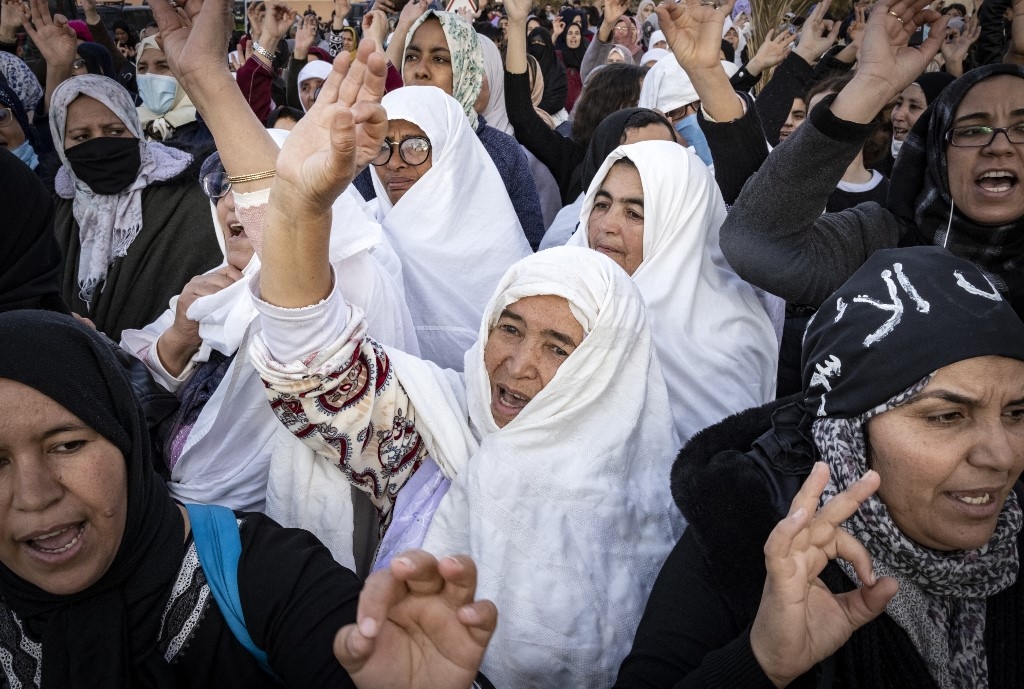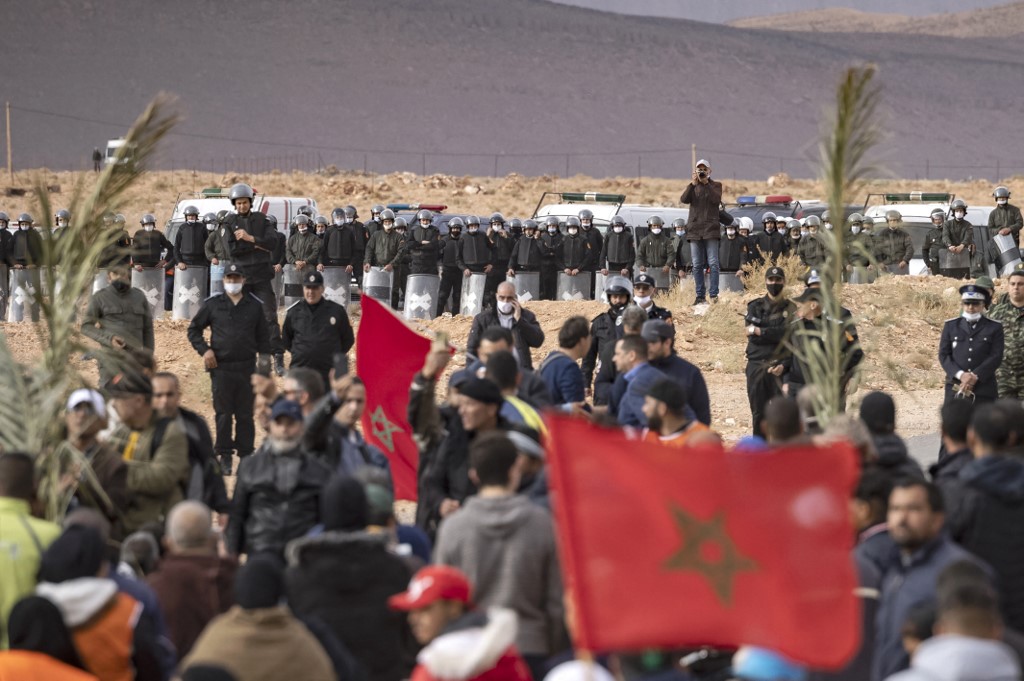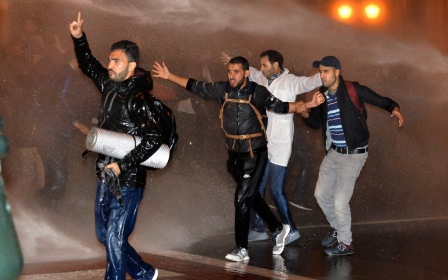Moroccan farmers' protests highlight the human toll of border dispute

In recent weeks, the Morocco-Algeria border has taken centre stage in the diplomatic conflict between the two Maghrebi nations. Dozens of Moroccan farmers have been ordered to leave the palm groves of El Arja, near the Moroccan town of Figuig, after Algerian soldiers entered the area and asserted that it was Algerian territory.
The contested status of the territory partly dates back to its poor definition in a 1972 agreement between the two countries, which cited, among other elements, an "unnamed river" as one of the border markers. While many Moroccans expressed frustration and confusion at the order to leave, Algerian authorities cited security issues and concerns about drug trafficking across the border - a common talking point in border matters. Local farmers, in the meantime, organised a sit-in.
While this event may be framed easily in the context of Moroccan-Algerian geopolitical rivalry, a full understanding must consider the history of the region and the people of the borderland, who have long had to cope with the fallout of their proximity to a contested symbol of changing state systems. This has meant adjusting to border changes, closures, war and expulsion.
Line in the sand
While the disagreement over El Arja today is, at least on paper, about a territorial border - a literal line in the sand - it is worth noting that the very conception of a nation delineated by territorialised borders is a relatively recent addition to state-building in the Maghreb. It is closely connected to Figuig itself.
New MEE newsletter: Jerusalem Dispatch
Sign up to get the latest insights and analysis on Israel-Palestine, alongside Turkey Unpacked and other MEE newsletters
As William Zartman highlights in his essay States, boundaries and sovereignty in the Middle East, it was only the 19th century and the influence of colonialism that increasingly saw a transition from a conception of boundaries centred on the population of a given political jurisdiction, to one that centred on territory itself.
French colonial influence was a primary driver in the territorialisation of the Morocco-Algeria border … setting up challenges and conflicts for years to come
While the 1845 treaty of Lalla Maghnia delineated some of the territorial border between Morocco and colonised Algeria, it stopped just south of Figuig. It explicitly argued that defining borders in desert land with no water would be “superfluous”. An echo of this still rings true in the vague and contested establishment of the territorial border around Figuig in the 1972 agreement, which is at the heart of the disagreement today.
If the people of the borderlands saw the creation of a border that was increasingly tied to territory and removed from their movements and practices, they have also seen these developments driven by decision-makers outside of their environment. French colonial influence was a primary driver in the territorialisation of the Morocco-Algeria border, both reshaping the area and setting up challenges and conflicts for years to come. Borderland residents and protesters often cite frustration at the fact that decisions that so intimately affect the people of Figuig, Oujda or Maghnia, are made in Rabat or Algiers.
Tumultuous relations
An early illustration of the conflictual relations between the everyday lives of borderland residents and the policies of border-drawing was the Sand War of 1963, which was spurred by the “ill-defined frontier limits between Algeria and Morocco inherited from the French colonial period”. Fighting around the towns of Bechar and Figuig developed into an open military confrontation that worsened after the Algerian attack on the Moroccan town of Ich.
In February 1964, a ceasefire was negotiated by the Organisation of African Unity, whose involvement played a crucial role in defining the meaning and shape of “African unity” in the post-independence period. The decision to put forward the principle of inviolability of frontiers inherited from the colonial period, aimed at settling border disputes, formalised the integration of the postcolonial nation into the modern state system.
On both sides, the official narrative framed the conflict as an ideological clash between a historical monarchy and a military regime - a distinction that remains prominent in many modern accounts of regional dynamics. The socio-psychological legacy of the war proved instrumental in sustaining tumultuous interstate relations, leading to the “black march” expulsions of 1975 and culminating with the official border closure in 1994.
The legacy of the Sand War prominently impacted the region’s collective memory, with mass expulsions of citizens on both sides. Documentary footage shows people in Figuig expressing their discontent and showing allegiance through nationalistic chants: “Long live Figuig. Long live King Hassan II.”
Media reporting and slogans at protests have linked the recent events in El Arja to Algeria’s 1975 expulsion of around 45,000 Moroccan families, who were forced to leave behind their properties and the lives they had built in the country. A painful chapter in the history of both nations, the expulsions have spurred ongoing calls for justice and restitution.
Reframing identities
The forced movement of populations, impacted by decisions issued from centres of power, has shaped interstate rivalries and is marked by a strong emotional narrative, in which trauma remains central. These dynamics have allowed states to reify their own powers, particularly in times of crisis; but the reinforcement of borders in the Maghreb also reframes collective and individual identities. This process of continuous adaptation is often marked by feelings of uncertainty, marginality and exclusion.
For the people of Figuig and all of the Morocco-Algeria borderlands, managing the fallout of the current dispute presents yet another challenge in navigating life along a changing and politically charged symbol at the heart of geopolitical rivalries. Through marches and protests, chants and stories, borderland residents have brought forward a distinctly domestic form of activism, reminding the state of its responsibility towards the territory it claims - and demanding justice and social inclusion for the communities on its periphery.
During protests this month, coffins inscribed with the words “Death of El Arja” were being transported from the centre of Figuig to El Arja, where protesters were stopped by Moroccan armed forces. Banners and chants were direct reminders of the importance of El Arja to the local population, which demanded it back.
Appeals to reform the borders highlight the frustrations and solidarities of Figuig’s borderland population, reminding the king and the state of their role as protectors, while also condemning corruption in the state apparatus and the marginalisation of farmers. A defiant assertion from a community often treated as pawns in diplomatic games played many miles away rang out: “Figuig is stronger than both countries.”
The views expressed in this article belong to the author and do not necessarily reflect the editorial policy of Middle East Eye.
Middle East Eye delivers independent and unrivalled coverage and analysis of the Middle East, North Africa and beyond. To learn more about republishing this content and the associated fees, please fill out this form. More about MEE can be found here.






